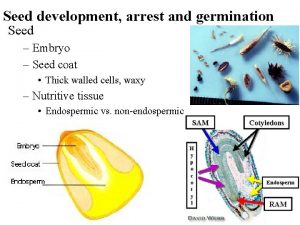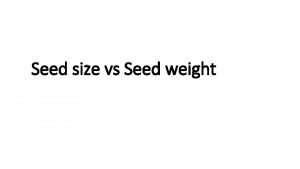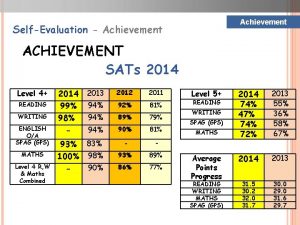Every achievement originates from the seed of determination





















- Slides: 21

Every achievement originates from the seed of determination. survival analysis 1

Survival Analysis Nonparametric Methods for Comparing Survival Distributions 2 survival analysis

Abbreviated Outline How to formally compare 2 or more survival distributions using hypothesis tests ¢ These tests look at weighted differences between the observed and expected hazard rates, allowing us to put more emphasis on certain parts of the curves ¢ 3 survival analysis

Hypotheses 4 survival analysis

Notation 5 survival analysis

Test Statistics 6 survival analysis

Test Statistics 7 survival analysis

Test Statistics 8 survival analysis

Test Statistics 9 survival analysis

Test Statistics 10 survival analysis

Test Statistics Reject Ho if U is too large. 11 survival analysis

Log-rank Test Constant weight function: Treat all observed failure times equally. ¢ It has optimum power to detect alternatives where the hazard rates in the M populations are proportional to each other ¢ 12 survival analysis

Proportional Hazard Assumption ¢ An underline assumption of many methods ¢ Suppose there are 2 groups of survival data. Then h 1(u)=c*h 2(u) where hi(u) is the hazard function of group i and c is a constant 13 survival analysis

Wilcoxon Test ¢ Survival time t(j) is weighted by nj, the number of individuals at risk at time t(j). ¢ This test is less sensitive than the logrank test to deviation of the observed to the expected in the tail of the distribution of survival times. 14 survival analysis

Example: 6 -MP ¢ To compare the survival distributions of the placebo group and the 6 -MP group using the log-rank test Test of Equality over Strata 15 Test Chi-Square DF Pr > Chi-Square Log-Rank Wilcoxon -2 Log(LR) 16. 7929 13. 4579 16. 4852 1 1 1 <. 0001 0. 0002 <. 0001 survival analysis

Stratified Tests Previously, we assumed that the various groups of individuals under comparison are homogeneous with respect to other factors which may affect survival time ¢ One way of detecting differences in survival between groups, while accounting for the effects of other factors is to stratify. ¢ 16 survival analysis

Stratified Tests ¢ 17 When the number of strata is large, a test typically has low power to detect treatment differences. survival analysis

Stratified Tests ¢ 18 Hypothesis: survival analysis

Stratified Tests 19 survival analysis

20 survival analysis

Example: 6 -MP ¢ ¢ ¢ 21 The patients are stratified according to remission status (partial or complete). Consider a test of Ho of no treatment effect, adjusting for the patient’s remission status. The stratified log-rank test (chisq=17. 9 and p-value = 2. 28 x 10^-5) indicates that the distribution of survival times is significantly different between 6 -MP and placebo groups. survival analysis
 An exogenous disease originates outside the body.
An exogenous disease originates outside the body. The view that knowledge originates in experience
The view that knowledge originates in experience Winds are labeled according to
Winds are labeled according to Nparks every child a seed
Nparks every child a seed Every child a seed
Every child a seed Every nation and every country
Every nation and every country Microsoft's mission statement
Microsoft's mission statement Every picture has a story and every story has a moment
Every picture has a story and every story has a moment Every knee shall bow every tongue confess
Every knee shall bow every tongue confess Every child every day
Every child every day Every rotarian every year
Every rotarian every year Every nation and every country has its
Every nation and every country has its Tư thế worms-breton
Tư thế worms-breton ưu thế lai là gì
ưu thế lai là gì Thẻ vin
Thẻ vin Cái miệng xinh xinh thế chỉ nói điều hay thôi
Cái miệng xinh xinh thế chỉ nói điều hay thôi Thể thơ truyền thống
Thể thơ truyền thống Các châu lục và đại dương trên thế giới
Các châu lục và đại dương trên thế giới Từ ngữ thể hiện lòng nhân hậu
Từ ngữ thể hiện lòng nhân hậu Diễn thế sinh thái là
Diễn thế sinh thái là Tư thế ngồi viết
Tư thế ngồi viết Slidetodoc
Slidetodoc








































